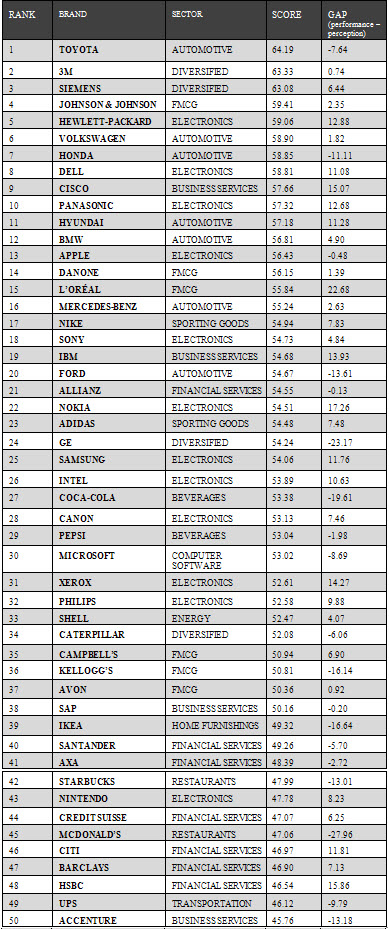Toyota (#1), 3M (#2) and Siemens (#3) lead Interbrand’s new global report, ‘Best Global Green Brands.’ In its first global report to focus exclusively on green, Interbrand, the leading brand consultancy, combines public perception of environmental sustainability (‘green’) with a demonstration of that performance based on publically available information and data.
The foundation of the ranking is Interbrand’s 2010 Best Global Brands report. Findings show that the strongest green brands consistently differentiate themselves and engage in green activities that consumers find relevant, as well as implement profitable green practices across their organization, from setting and executing environmental programs to effectively measuring and reporting their performance to the public.
“As corporate citizenship increasingly becomes the norm, green initiatives may be among the most visible and easiest to claim and yet, can be the most challenging to deliver performance against,” said Jez Frampton, Global Chief Executive Officer at Interbrand. “We believe the strongest green brands lie at the intersection of performance and perception: their ability to build stronger connections with consumers as a result of actionable and credible environmental practices.”
Consumers in the 10 largest markets: the US, Japan, China, Germany, France, the UK, Italy, Brazil, Spain, and India were asked how green impacts their purchase decisions and their overall understanding and awareness of the brand’s green activities as a whole.
The rankings developed by Interbrand are based, in part, on quantitative performance scores derived from an analysis of publicly available information. Deloitte was engaged to develop an environmental sustainability performance methodology based on publicly available data as an input to Interbrand’s overall scoring methodology. These performance scores were one of the many factors Interbrand considered when creating the final rankings. The finalized score is a combined metric taken from both a perception and performance calculation. Taken together, the resulting difference or gap between these two scores represents the potential misalignment between brand performance and consumer perception.
Key findings from the study include:
—The automotive industry and electronics category lead the way not only in their ability to implement sustainable practices across their organization, but also in their ability to communicate their efforts effectively to the public.
—A number of brands show large gaps between performance and perception. L’Oréal, Nokia, and HSBC all scored significantly higher in performance than perception, suggesting that while they are doing great things internally in terms of environmental sustainability, they are still not yet communicating their efforts to consumers as clearly as they could.
—McDonald’s, GE, and Coca-Cola, on the other hand, all scored significantly higher in perception than performance. This suggests that these highly visible brands enjoy the positive impact of being a well known, powerful brand, with green perception matching general perception overall.
